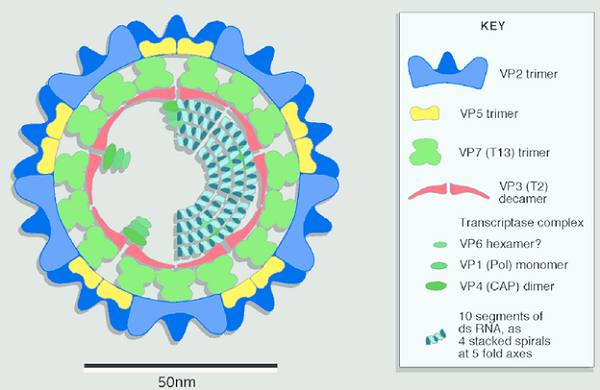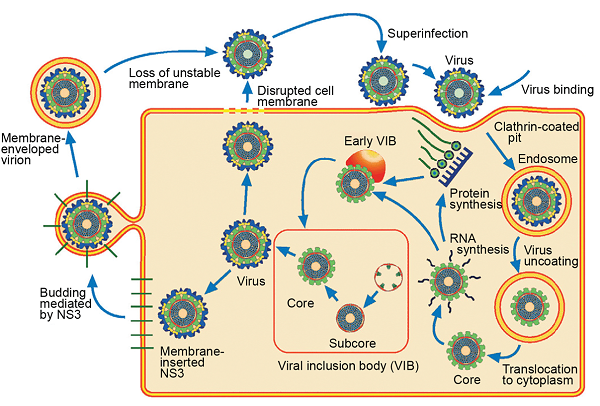Orbivirus - Classification, Morphology, Genome, Lab diagnosis, Pathogenesis, Replication, Clinical manifestation
Classification of Orbivirus
The classification of Orbivirus can be done by:
Realm: Riboviria
Kingdom: Orthornavirae
Phylum: Duplornaviricota
Class: Resentoviricetes
Order: Reovirales
Family: Reoviridae
Subfamily: Sedoreovirinae
Genus: Orbivirus
Characteristics of Orbivirus
Orbivirus is primarily animal pathogens that cause disease mainly in animals. Transmission of the virus occurs by ticks, mosquitoes, and sandflies. The genera have 22 species and 130 subspecies.
Morphology of Orbivirus
Orbivirus has icosahedral symmetry, which is non-enveloped and is 70-80 nm in diameter. Morphologically, the virions have two layered capsids (VP2 and VP5- outer layered). The viral proteins VP2 and VP5 are attached to VP7.
The inner layer (core particle) has 260 trimers of VP7 arranged in a ring-like structure. VP7 is associated with a sub-core shell composed of 120 copies of VP3. VP3 surrounds transcriptase complex (VP1, VP4, and VP6) and genomic RNA segments.

Fig: Orbivirus morphology (Source: ResearchGate)
Genome of Orbivirus
The genome of Orbivirus is double-stranded RNA whose size is 18 kbp. There are 10 genome segments that encode 7 structural proteins VP1 to VP7 and four Non-structural proteins (NS1 and NS4).
Clinical manifestation of Orbivirus
Orbivirus infections are mostly asymptomatic. Manifestations include fever, nausea, abdominal pain, headache, and myalgia. It also causes flu-like disease, encephalitis, and polyradiculitis.
Neurological complications include meningitis or encephalitis.
Replication of Orbivirus
The Orbivirus replicates in the cytoplasm of infected cells. Attachment occurs via a specific protein component of the outer capsid. i.e. σ 1 to cellular receptor i.e. sialic acid and junction adhesion molecule A.
The viral protein-cellular receptor interaction leads to a conformational change in the viral capsid. This enables viruses to enter cells by receptor-mediated endocytosis. The outer capsid is removed, but the viral particle is never completely uncoated.
The viral genome RNA remains in the core of the sub-viral particle (double-layered particle). RNS-dependent RNA polymerase transcribes RNA to give mRNA. The mRNA molecules which are 5’ capped by not polyadenylated leave the subviral particle through channels present in outer and inner capsids.
The mRNA is translated to generate various viral proteins. The mRNA also acts as a template for RNS replication. RNA polymerase aids the replication process. Viral genome RNA is packed within new core structures.
Double-layered virion particles bond to intracellular viral receptors (NSP4) and buds from ER. During budding through ER, double-layered virion particles transiently acquire an envelope.
At the same time, outer capsid proteins, VP7 and VP4 are incorporated into new virions which become mature. They lose the envelope (transiently acquired from ER) and are passed through the Golgi apparatus. They are finally released from enterocytes.

Fig: Orbivirus replication (Source: ResearchGate)
Pathogenesis of Orbivirus
Transmission of Orbivirus is via arthropod-borne mosquitoes (Aedes), ticks, and sand flies. Only a few orbiviruses are linked to disease in humans (50 cases reported in total).
Eg: Kemerovo virus, Orungovirus, Lembombo virus, Oklahoma tick fever, Changuinola virus
Laboratory diagnosis of Orbivirus
The laboratory diagnosis of Orbivirus is mostly based on serodiagnosis and is usually done in reference labs.
Isolation
Orbivirus can be isolated in cell line cultures such as Vero Cells, and BHK-21 cells.
Animal inoculation can be done in suckling mice.
Serodiagnosis
Numerous methods used for serodiagnosis of Orbivirus include:
EIA
CFT
Neutralization
Four-fold rise in virus-specific Ab titer (IgM, IgG)
ELISA is used to detect virus-specific IgM Ab in CSF of patients with neurological complication
Treatment of Orbivirus
The treatment of Orbivirus can be done by:
No specific treatment
Use of insect repellent, clothing, avoidance of tick bite